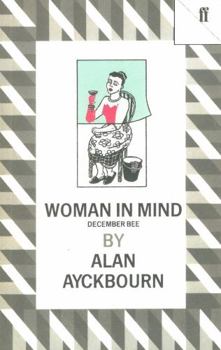Woman in Mind: December Bee
Select Format
Select Condition 
Book Overview
Susan, a hard-working, somewhat neglected parson's wife, fantasizes an ideal family to make up for her sterile home life.
Format:Paperback
Language:English
ISBN:0571145205
ISBN13:9780571145201
Release Date:January 1986
Publisher:Faber & Faber
Length:92 Pages
Weight:0.20 lbs.
Dimensions:8.0" x 0.3" x 5.0"
Customer Reviews
3 ratings
Chew Lee Aim At Surplice
Published by Thriftbooks.com User , 16 years ago
I was in a production of this in community theatre, and it was a lot of fun. The concepts and language are certainly palatable for a mainstream audience, while the plot and characters provide plenty of meat for eager actors. The subtitle of the show -- "December Bee" -- refers to how the lead character speaks once she starts to go mad. She speaks English words, but for their sound similarity to what she's trying to say. "December Bee" should be "Remember Me". See if you can guess what the title of the review says. I've seen some other of A.A.'s play since, and this feels like his typical quality: interesting people and situations, with some kind of overlap to keep the audience on its toes.
A really good play.
Published by Thriftbooks.com User , 23 years ago
... Its about a woman named Susan whom while garden steps on a rake causing the end to him her in the head and knock her out. And from this point on we see her getting more and more dilusional and not even being able to distinguishing fantasy from reality or sometimes intermingling them. Susan no longer loves her husband, he's always to busy writing, they even sleep in seperate beds now. Their son hasn't talked to them(Or more so her)in years since he's been at some philisophical/religious institution. And also living in their house is her husband Gerald's sister "Muriel" whom Susan despises, Muriel is a terribly airheaded cook who believes her husband will come back from the dead for her. So now we see through Susans eyes and meet her dilusionally perfect family: Her husband: Andy, Her brother: Tony, and her Daughter: Lucy. Each is truely kind and loving, but have harsh sides to them. These dilusions were thus created as a need for love and emotions for Susan. She was feeling unsatisfied and she needed more then she had. Which at first she found in her fantasy family. Another character who comes in at the beginning is Bill; the Doctor. This shows the degeneration of modern families and to the extremes one may take to escape it and find the emotions that have once been forever lost in work. And the love and tenderness that has desinigrated and the fantasies created in longing for these things.This is a *GREAT* read, I definetely RECOMEND IT!!!*Enjoy*!God Bless ~Amy
Ayckbourn declares war on the conventional family Pattern
Published by Thriftbooks.com User , 25 years ago
Woman in Mind is very remarkable for its representation and misrepresentation of reality. In the play, Susan, a totally disoriented woman, finds herself entagled in a viscious web of existence devoured by reality and virtuality. The real world she perceives is composed of her husband, Gerald, a boring clergyman, her boring and inefficient sister in Law, Muriel, and her irresponsive, introvert son, Rick, along side with Dr Bill Windsor who is a substitute doctor for the towns original medic. The virtual world on the other hand is composed of similar presence: Andy, a much more colorful and lively husband than the real one, Tony, an easy going, flamboyant brother, and Lucy , a charming and sweet daughter, along side with Bill Windsor, the family's substitute doctor. Thus Woman in Mind is presented on stage as well as on page ýn two frames or settýngs juxtaposed sýde by side and sometimes superimposed on each other: the real and the virtual. In both of the frames there is the conventional, traditional family pattern. However, the only difference between the two patterns is that the real is much less colorful than the virtual. The first sordid family represents Susan's real world. A dull world inhabited by dull people. In order to escape this grisly world she creates a colorful family in her mind and begins to communicate and live with them. Her virtual husband, brother and daughter, unlike her real ones, care a lot about her, eager to please her and very sensitive to her needs emotionally and physically. So far so good. But then suddenly her virtual world, like her real one, begins to collapse. The loving simulacra she creates begin to ignore her commands, violate her privacy and take control over her real life. When she tries to resist them by trying to switch them off, she fails and her system crashes. This crash is manifested in the last scene when she no longer is able to distinguish between the real and the virtual,and all the world appears to her as a mutated virtuality.The most dangerous question the play poses is why Susan's virtual world collapses. A very simplistic answer is because reality comes first, and any rejection of reality is bound to backfire and lead to such conclusion. A very main stream understanding of a middle class British morality text. But is this all? No. Somewhere in the play itself Andy warns ,or may be significantly, points out to Susan that "nothing is what it is" Indeed, the significations of the events may not look as what they appear to be. In the text, Susan in order to escape her reality of family life and marriage entrapment, resorts to fantasy. In reality, as we are made to understand, she is mainly depressed because basically her sexual and emotional needs are not well met by her clergy husband and introvert son. So to compensate, she resolts to substitution. She creates a virtual verile, slightly younger than her husband and a doting daughter. This fantasy works f





